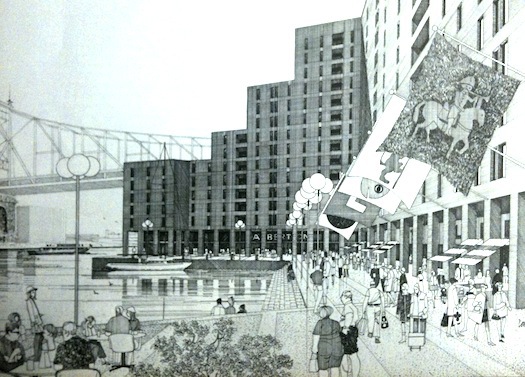
Johnson/Burgee plan for the "Island Nobody Knows." The stepped marina facing Queens was modeled on Indian ghats.
Earlier this week I took a ride out to Roosevelt Island, inspired to look into the site that will soon be developed into a tech campus by Cornell University and the Technion-Israel Institute of Technology. You have no doubt heard about this project, which will be a cornerstone of our very tech-savvy mayor's legacy. Most reports about the project thus far have focussed, justifiably, on the economics of the endeavor—I've seen the figure $2 billion floated as a total cost, and the city is claiming it will, over time, generate some $23 billion in revenue and 600 new companies.
I'm interested in those matters, but I'm also concerned about what this new site will be architecturally, and perhaps more importantly, what the new plan will mean for Roosevelt Island. (This is of special interest given my research into the career of Philip Johnson, as you will see.) One immediate concern was that, in all the reports I read about the project, there was no mention of the future of Goldwater Hospital, a fully operational facility that occupies the site in question.
There is a certain fundamentalist line of thinking according to which it is never appropriate to tear down a building. I'm not of that belief—I don't think you can be if you live in New York—and Goldwater, a 1939 complex designed by Isador Rosenfield, is not a work so distinguished that it merits preservation. It is a slightly depressing assemblage of chevron-shaped greige structures of three stories, connected by a central spine. It is not terrible—the wedged orientation of the pavilions provide good views of the city—but it's no landmark and—good news—the city is spending $266 million to build a replacement facility on a parking lot adjacent to Harlem's North General Hospital, which will also be partially renovated to create a new Goldwater North.
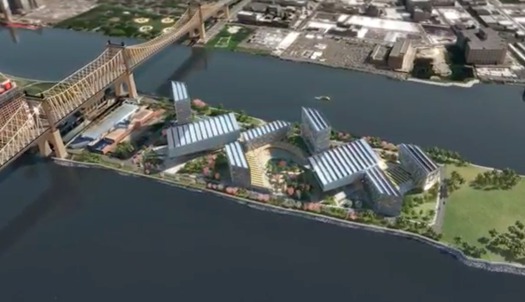
Aerial view of the Duffy/SOM plan.
As envisioned by SOM's Roger Duffy, the Cornell/Technion campus will be a shiny work of advanced building technology, a dramatic assemblage of eight metallic structures connected by a network of elevated pedestrian pathways and green spaces with plenty of public space. It will, appropriately, be environmentally sustainable, generating its own power from solar arrays and geothermal wells.
Duffy's vision is alluring and progressive, and I hope he has the opportunity to implement it. But it is not the first alluring and progressive urban plan to be proposed for Roosevelt Island, and we would all do well to learn from the failures of the past.
In the late 1960s, Philip Johnson and John Burgee created a master plan for "The Island Nobody Knows." At the time, the place was an isolated dumping ground where the city could safely remove the sick, the elderly, the indigent, the mentally ill, and the criminal. Goldwater is a remnant of that era, but so are some of the island's monuments, notably James Renwick's smallpox hospital, now a romantic ruin at the southern end of the island. It is adjacent to a memorial, designed by Lou Kahn and now under construction, for FDR, who was himself disabled.
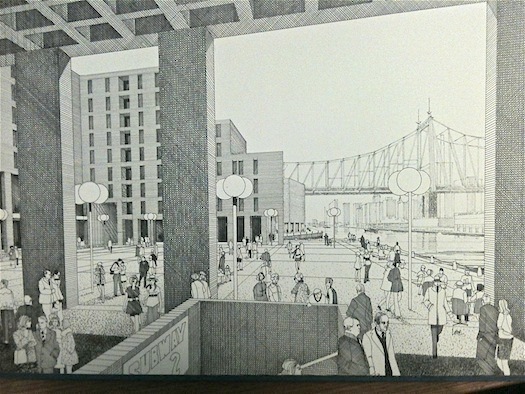
Town square of the Johnson/Burgee plan, facing Manhattan and the Queensboro Bridge.
Johnson today is remembered as an architect of the elite and of corporate interests, but the design for Roosevelt Island came at an altruistic moment, and was from the outset designed as a mixed-use, utopian community characteristic of that era—a "New Town in Town". The plan was not fully realized (the centerpiece was to be an arcaded mall modeled on the Italian shopping gallerias), but the essential contours of the Johnson and Burgee proposal were followed.
I remember travelling there often when I was young. My uncle, a liberal among liberals, was one of the first to move in. He loved it there, as did my aunt. I think they felt they were part of a new and more egalitarian society. That seemed true, but I felt as if that society was not one that I was interested in joining. It was like a toy place—it still has a pneumatic garbage system, just like Disney World—with little energy on the streets, few restaurants, nothing to draw me there besides a family obligation. I liked the trip across on the tram, but had trouble taking it seriously.
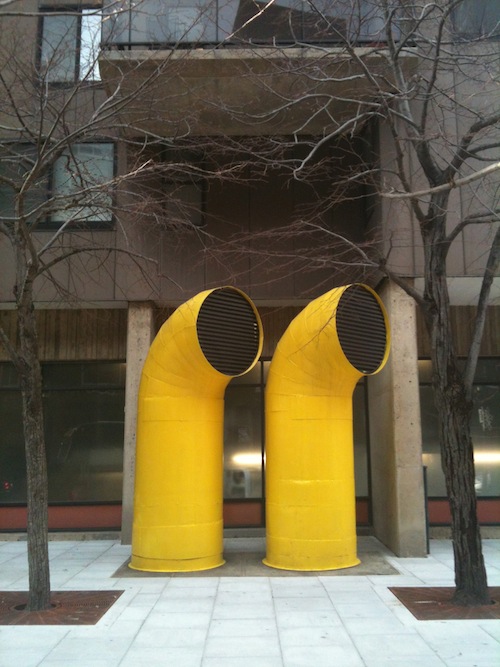
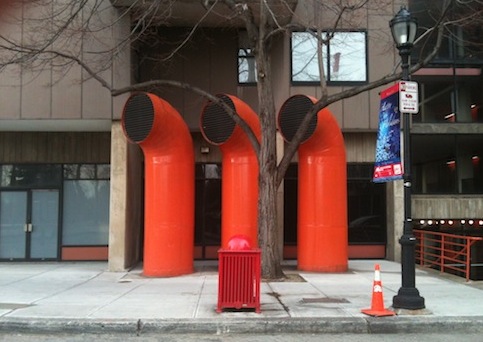
Roosevelt Island, today. Programmed charm.
Visiting it today is a bit like travelling back in time; it has not changed at all, or at least not in any meaningful way—there are some new condos—in the intervening years. It remains a pleasant, comfortable place to live, but the highly centralized planning means there's not much in the way of street life or urban energy, and there's no real cultural institution that brings people to the place from elsewhere. My daughter, for instance, loves the tram. She gets on in Manhattan, takes a ride across, and then gets right back on again for the return trip. The highlight of her stay is leaving.
And so we come back to the current proposal. While it's too much to ask for the Cornell/Technion plan to resolve all the deficiencies of the past, it can at least ameliorate some of them. The primary issue with that original design was the deadening sameness it imposed, and one fear of the new is that it, too, is a wholistic, unified plan. The object, however, should not be to create some kind of architectural theme park, but to make a vibrant urban space, and hopefully do something to suture the island, now divided into two separate and largely non-communicative halves, bisected by the Queensboro Bridge. The new plan just might do that. Herewith a few thoughts on ways this might be accomplished, with the caveat that some or all of them may well be under consideration already.
-Retail: there isn't much decent retail space on the north end of the island, and the new population of Cornell/Technion will demand its own resources. Maybe its time to incorporate the galleria—not mall!—Johnson/Burgee envisioned forty years ago. The fly throughs of Duffy's design indicate a great deal of open space, but don't indicate much about programming, or how public it will be.
-A cultural lynchpin: A lot of money is being spent to develop a science center; why not reserve some space for collaborative arts/design studios and programming that can feed off that research? The lines between art, design, and tech seem to be collapsing these days. How about a museum of electronic gaming? MIT has a museum in Cambridge that could also be a model. The island needs a magnet, and it could also use something to draw tourists toward the FDR memorial.Finally, while taking my tour of the island I noticed that two retired trams are sitting in a cage, unused at the Motorgate garage terminal. I don't know if there's a plan for them, but it would be nice to see at least one of them incorporated into a park on the island—perhaps at my imagined ferry terminal. I'm sure kids would love that. The other, perhaps, could go in some public space in Manhattan where it could serve as an advertisement for the island.
-Ferry service: You can access Roosevelt Island by car, tram, and subway. Why not water? This would be especially useful from Brooklyn, which is connected only by a long trip on the F subway.
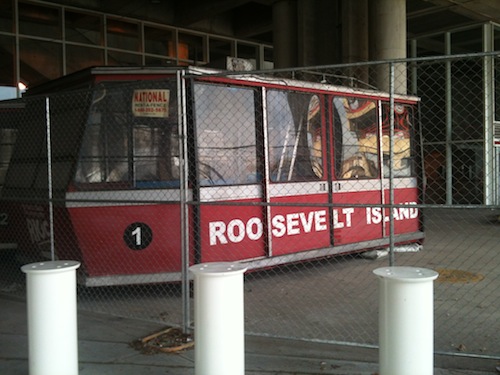
Tram jail. Free the trams!
